Dublin in 1922: A Sketch
 A sketch of Dublin city on the eve of Irish independence. By John Dorney
A sketch of Dublin city on the eve of Irish independence. By John Dorney
Dublin city, bounded by its two canals, had a population of about 320,000 in 1922. Add in the suburbs, which had been inching outwards along the new railway lines since the mid 19th century and the urban area was home to over half a million people.
Industry
Dublin had never had an industrial revolution like most British cities, or even Belfast, but still according to the census of 1911 employed 73,000 manual workers. The docks were crowded with ships exporting and importing. The Anglo-American Oil Company had built large storage tanks on the docks in 1897 and the Great Southern and Western railway built its lines into the docks in 1873. [1]
The railways had first arrived in the 1840s and by the 1870s had transformed much of the city, rapidly speeding up the transport of goods around the country, which had previously been confined to the pace of a tow horse along the city’s two canals. They also made possible the creation of new suburbs far beyond the old city centre.
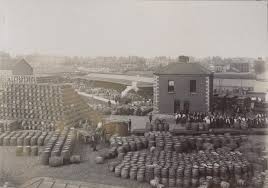
Dublin’s lighting and power was gradually becoming electrified and its water was piped in from the Vartry reservoir, constructed in the 1860s.
Tram lines criss-crossed the city, part of the burgeoning business empire of the Murphy family – Dublin’s first Catholic multi-millionaires, in a business sector still dominated by Protestants.
Its patriarch William Martin Murphy, locked horns with labour leader Jim Larkin during the great strike and lockout of 1913, when 20,000 workers had struck for the right to organise.
Dublin had never had a classical industrial revolution.
Guinness famously brewed beer and Jameson distilled whiskey along the Liffey, and there were several small breweries and distilleries nearby. Further up-river was the Irish Bottling Plant at Charlotte Quay.[2] Since the 1860s the city centre had also been graced by large department stores, the most famous of which were Arnotts, Brown Thomas and Switzers.
New working class suburbs had sprung up outside the old city centre in areas such as Inchicore around the railway lines and more middle class ones around Drumcondra on the northside and the South Circular Road south of the Liffey. On the southside the patrician Georgian areas, Fitzwilliam Square, Merrion Square, Baggot Street, had been kept more or less intact and was still home to a prosperous, largely Protestant upper middle class.
City Politics
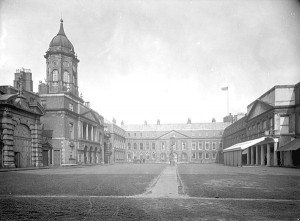
In the eighteenth century Dublin had been a Protestant city, but due to rural migration Catholics had become the majority by the early 19th century. Catholic nationalists, first O’Connellite ‘Repealers’ and later Parnellite ‘Home Rulers’ had taken over control of the city’s Corporation as far back as the 1840s when the voting system was reformed to include all property holders regardless of religion.
The Liberal Under Secretary for Ireland Thomas Drummond, reformed Dublin Corporation in 1840 so that it was elected on the basis of property ownership (of over £10 per year) rather than religion, Catholic voters immediately outnumbered Protestants by over two to one. Daniel O’Connell became Lord Mayor of the city in 1841, the first Catholic to hold the position since 1689.[3] Thereafter, until the 1860s, in order to avoid sectarian animosity, the office of Lord Mayor was alternated every term between Catholic and Protestant. After the 1880s, however, the city government became solidly nationalist.
From the 1880s onwards, control of Dublin Corporation had been in the hands of Irish nationalists.
In 1898, the British extended the powers of local government in Ireland, effectively devolving local power to nationalist and Catholic representatives where they were a majority, meaning that Dublin Corporation in particular became a stronghold of constitutional nationalists, who viewed it as an Irish parliament-in-waiting.[4]
Nevertheless, up until 1922, including in the general election of 1918, Dublin continued to elect Unionist Members of Parliament alongside nationalists.
Dublin’s monuments spoke of the city’s contested politics. The name of the main street was in the process of being changed from Sackville Street to O’Connell Street and adjoining Great Britain Street was being re-named Parnell Street. On O’Connell Street itself, statues of nationalist leaders O’Connell and Parnell were overlooked by a pillar in honour of Admiral Nelson.
When King George V visited in 1911, Dublin was draped in Union flags, and crowds of ‘every class and creed’, as the Irish Times reported, did indeed cheer the king. But Dublin Corporation, dominated by nationalists of the Home Rule Party of John Redmond, boycotted the official reception. [5]
Democratic control over the city was not complete under British rule. The British administration in Dublin Castle still controlled, up to 1922, the main levers of power directly, including the police. Dublin was policed up until revolutionary times by the Dublin Metropolitan Police a –mostly unarmed corps about 1,100 men strong. While there had long been high rates of petty crime, Dublin was not, before the First World War, a violent city. In the early 1900s about 80% of the 3,000 or so offences recorded every year were comprised of non-violent theft and most of the rest were connected with drunkenness and assault, with usually only about two to three murders a year [6].
While nationalists had long held municipal political power in Dublin, by 1922, only about one in ten of its population had the right to vote. The Corporation had an electorate of 38,000, including some women.[7]
Protestants and Catholics
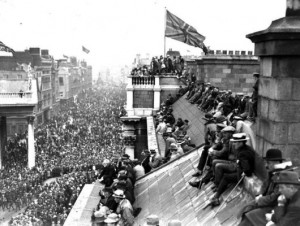
In response to nationalists political advances, many Protestant and unionists had moved out of the city proper and set up their own autonomous townships at places like Rathmines and Pembroke. Later their children moved further out of the city again to the ‘railway townships’ of Kingstown, Blackrock, Dalkey and Killiney. [8]
Dublin Corporation only managed to recover the near townships and their much needed tax base in 1901, and then by threatening to exclude the townships from the city’s water supply if they did not come back into its tax fold.[9]
By 1922, roughly 20% of the population of Dublin was Protestant – a percentage that would drop sharply after Irish independence. Sectarianism was ever present in early 20th century Dublin, but its tended to be of the casual rather than the virulent kind. In the early 1900s it was sharpened by the rivalry between the Catholic and Protestant Churches over who would have custody, and therefore spiritual authority, over orphans.
Sectarianism was real in early twentieth century Dublin, but the city was not segregated on religious as much as class lines.
Todd Andrews a scion of the Dublin Catholic lower middle class, thought that, ‘from childhood I was aware that there were two separate and imiscible [impossible to mix] kinds of citizens: the Catholics, of whom I was one and the Protestants, who were as remote and different from us as if they had been blacks and we whites’.
‘We were not acquainted with the Protestant community, but we knew they were there, a hostile element in the community, vaguely menacing us with such horrors as Mrs Smyth’s homes for orphans where children might be brought and turned into Protestants’. That said, when his father caught him spitting at a Protestant Church, he recalled receiving a long lecture he did not fully understand, but leaving him in no doubt not to do it again.[10]
Andrews further differentiated between his class and ‘Castle Catholics’ – the upper middle class – so-called because of their integration with the British administration located at Dublin Castle – whose ‘accents were indistinguishable from those of Dublin Protestants’ who played golf, cricket and rugby and who ‘lived cheek by jowl with the Protestants on Mountjoy Square, Fitzwilliam Square or in Foxrock, Dalkey or Kingstown’.
The city also had a small Jewish enclave along the South Circular Road, inhabited by Jews who had left the Russian Empire since the 1880s, mostly from modern Lithuania. It was about 4-5,000 strong in 1922.
The middle class, Catholic and Protestant and other, amounted to about 20% of the city’s workforce – the 1911 census listed 18,000 in the ‘professional class’ with another 23,000 in the ‘commercial class’ and they employed some 18,000 domestic servants, counted as the ‘domestic class’.
Andrews own social milieu, the Catholic lower middle class, were more nationalist, played soccer as opposed to rugby, and hoped only for a secure job, preferably in the civil service. The Gaelic revival and its attendant sports tended to be minority tastes in Dublin. While the Catholic lower middle class were religiously observant, they were not generally devout, keeping neither ‘too close nor too distant from the clergy’ in Andrews’ recollection.
One of the major factors separating the two major religions was education, which was, since the mid 19th century, in the hands of the two main Churches – Catholic and Church of Ireland. Additionally at third level, Protestants generally attended Trinity College, while only the ‘Castle Catholics’ were confident enough to defy the Catholic Church’s ban on Catholics studying there. Most Catholic third level students attended the Catholic ‘National University’ (forerunner of today’s University College Dublin) at Earlsfort Terrace.
Slums
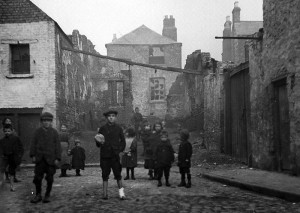
‘At the bottom of the heap’, Todd Andrews thought, were the inhabitants of the slums who were ‘seldom above the poverty line and many of them far below it’.
According to Andrews, they ‘supplied the rank and file of the [British regiment] Dublin Fusiliers’ and found their only entertainment in the pubs or on the terraces of the city’s football (soccer) grounds Dalymount or Shelbourne Park. They were religious in a superstitious way, ‘there was always a statue of the Blessed Virgin, the Sacred Heart and perhaps the Infant of Prague on the mantelpiece’. ‘They accepted their misery as the will of God’.[11]
Dublin had some of the worst slums in contemporary Europe.
Dublin’s real segregation was not between Catholic and Protestant, but between rich and poor. Whereas most of the middle classes lived in the new suburbs and took the trains or trams or cycled, or by the 1920s, drove, into the city centre, the population of the heart of the city was increasingly impoverished.
Dublin’s old Georgian core, particularly on the northside was notoriously riven with slums. What had once been the homes of grandees and merchants had over the course of the 19th century become dilapidated tenements, inhabited by the poorest, unskilled section of the Dublin working population, whose men were generally employed in casual labour, particularly on the docks, meaning that at the best of times their wages were low and many were often unemployed.
Many memories of the Dublin tenements, which were largely cleared in the period from the 1930s to the 1960s, remember fondly their sense of community, since lost in anonymous suburbs. However the reality of the tenements was stark.
In 1911, 33% of Dublin’s families lived in one room tenements.[12] Some 50,000 people were thought to be in need of re-housing by 1918. By the 1920s the situation had actually got worse.[13] The slums were notoriously unhealthy. Poverty, bad diet and poor housing meant that Dublin had an unenviable mortality rate of 23.1 % in 1914 compared to 18% in Belfast and 14% in London [14]
Poverty and the large British Army garrison combined to produce the ‘Monto’ around Montgomery Street – reputed to be Europe’s largest concentration of street prostitution – in the north inner city. The Dublin Metropolitan Police estimated in 1901 that while female prostitution was decreasing there were still over 1,500 women earning a living as prostitutes on the streets of the capital. There were 1,067 arrests for prostitution in 1912.[15]
James Larkin the messianic labour leader, who had organised the city’s lumpen proletariat into trade unions for the first time, commented on the prevalence of street prostitution and in In 1907 he wondered, ‘If Dublin men were so proud of their city’, why they did not put a stop ‘to the disgraceful scenes in O’Connell Street, when fellows from the slums of London, in red [British Army] uniform, were coming along with Irish girls on their arms, whom they would ruin in body and soul’. [16]
The census of 1911 listed a further 170,000 ‘Indefinite and non-productive class’ meaning children, women in the home and, about half, the unemployed.[17]
Dublin was known for its irreverent wit, which Todd Andrews at least remarked, was much overrated, ‘in fact the wit practiced in Dublin was and is essentially no better than jeering and has its basis in envy and a desire to denigrate’.[18]
Destruction and hope
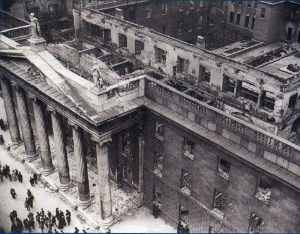
In 1922, for the first time since the Act of Union in 1801, Dublin was again on the brink of becoming a capital city.
Its last period as the political centre of Ireland had seen the construction of most of its grandest buildings – the Four Courts, the Custom House, the Parliament building (now the Bank of Ireland) and City Hall with their distinctive Georgian domes and columns, and shortly afterwards, the General Post Office which was finished in 1818.
But it was also, in 1922 a city that had passed through 6 years of violent nationalist revolution. By January 1922 many of these sites of symbolic power lay in ruins. The GPO and much of O’Connell Street was destroyed in the Rising of 1916, the Custom House left a burnt out shell after an IRA raid of May 1921.
The revolutionary years saw many of Dublin’s finest buildings destroyed.
In the Civil War of 1922-23, there was yet more destruction; the Four Courts pulverised and gutted by artillery bombardment and huge detonation of explosives, the eastern side of O’Connell Street that had been spared the fighting in Easter week 1916 was bombed and burnt out in the fighting between pro and anti-Treaty factions in July 1922. Nor was the damage all physical. About 5,000 Dubliners had died in the First World War and roughly another thousand died in political violence at home in the city between 1916 and 1923.
Dublin’s local government was also a casualty of the Civil War. Due to the Corporation’s neutral stance during the conflict and its criticism of some government actions, local elections due to take place in January 1923 were postponed by the Government.[19] In 1923 Dublin Corporation was restructured and a city accountant appointed. Then, following an inquiry that uncovered corruption in a municipal housing scheme, the Corporation was abolished altogether and its function taken over by three commissioners. It was not restored until 1930 and then with much reduced powers.[20]
And yet there were already springs of a new order in 1922. It had originally been thought that an Irish parliament would resume in the old parliament building, now occupied by the Bank of Ireland. The Bank was reluctant to move, however and its facilities were in any case outmoded for the new independent Irish parliament. In the autumn of 1922 the Provisional Irish Government acquired, from the Royal Dublin Society, Leinster House and adjoining Merrion Street buildings, all once the stately residence of the Duke of Leinster, to house the Dail and the Senate and government buildings. There they have remained ever since.
Dublin Castle, the centre of British rule, was handed over to the Free State in the spring of 1922, where it role became basically symbolic. The Vice Regal Lodge in the Phoenix Park, where the British Lord Lieutenant had lived, became the Governor General’s residence and later Aras an Uachtarain, the seat of the Irish President after 1937.
Irish independence did not solve Dublin’s social problems overnight, or indeed for many decades, but when the last British garrison marched out of the city and took ship for Britain in December 1922, it was, at least, a new start.

References
[1] Joseph Brady, Dublin at the Turn of the Century in Dublin Through Space and Time, P256
[2] Brady p 303-312
[3] Hill, Jacqueline. The Protestant Response to Repeal, the case of the Dublin working class in Ireland Under the Union (Lyons and Hawkins eds), Clarendon 1980. pp.45-46
[4] See Lee, Joseph, The Modernisation of Irish Society.
[5] Irish Times Thursday, July 13, 1911
[6] Joseph V O’Brien, Dear Dirty Dublin, A city in Distress, 1899-1916, p180-185
[7] Peter Murray, Electoral Politics and the Dublin Working Class before the First World War, Saothar, Irish Labour History Society, Journal Vol. 6, 1980
[8] Brady p265
[9] Seamus O Maitiu Dublin’s Suburban towns 1834-1930, Four Courts Press Dublin, 2003, P142
[10] CS Andrews, Dublin Made Me, Lilliput Press 2009 pp.4, 31.
[11] Andrews p.6-7
[12] Louis Cullen, Health and Housing in Dublin, 1850-1921, in Dublin, City and County, From Prehistory to Present, ed Kevin Whelan, F.H.A Aalen, Geography Publications, Dublin 1992. p282
[13] Cullen p 282
[14] All above figures from Padraig Yeates, Dublin 1914-1918, A City in Wartime, p7-11
[15] History Ireland, August 2013, https://www.historyireland.com/20th-century-contemporary-history/prostitution/
[16] History Ireland, August 2013, https://www.historyireland.com/20th-century-contemporary-history/prostitution/
[17] Brady p 263-264
[18] Andrews, Dublin Made Me p22
[19] O Maitiu Dublin’s Suburban Towns, p204
[20] David McEllin, The Legendary Mayor Alfie Byrne in Leaders of the City, Lisa Marie Griffith, Ruth McManus, eds, Four Courts Press, Dublin 2013 p154